Anglerfish
The anglerfish has a glowing lure on its head to attract unsuspecting prey
Advertisement
Anglerfish Scientific Classification
Read our Complete Guide to Classification of Animals.
Anglerfish Conservation Status
Anglerfish Facts
- Prey
- Crustaceans and fish
- Group Behavior
- Solitary
- Fun Fact
- The anglerfish has a glowing lure on its head to attract unsuspecting prey
- Estimated Population Size
- Unknown
View all of the Anglerfish images!
The anglerfish is an order of deep-sea predators, some of them living at depths of more than 6,000 feet where sunlight is almost completely absent.
This marine creature is very well-known for its bizarre appearance, sharp fangs, and bioluminescent lure extending from the top of the head, making it a truly rare deep sea creature. This lure is perhaps the most important of its adaptations. Filled with light-emitting bacteria, it draws in unsuspecting prey while the fish lies in wait to nab them. The technical term for the lure is the illicium.
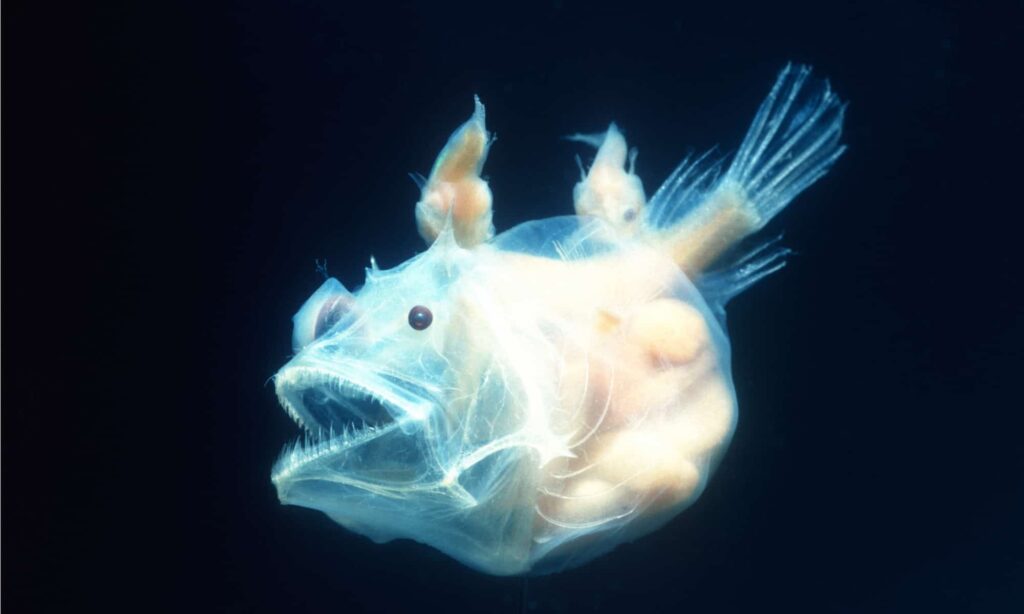
Some Anglerfish are filled with light-emitting bacteria.
©Neil Bromhall/Shutterstock.com
3 Incredible Anglerfish Facts!
- Based on genetic analysis, it’s thought that the anglerfish first evolved in the Cretaceous Period, some 100 to 130 million years ago.
- The lure of the “fishing rod” is actually a modified spine of the dorsal fin.
- One of the most interacting facts is that some species of anglerfish have glowing bioluminescent organs in addition to the light from their “fishing rods.” These might be adaptations to help them navigate in the dark.
Read more interesting facts about anglerfish here.

The lure of the “fishing rod” is actually a modified spine of the dorsal fin.
©Martin Voeller/Shutterstock.com
Classification and Scientific Name
The scientific name of the anglerfish is Lophiiformes. This derives from the Greek word lophius, meaning crest.
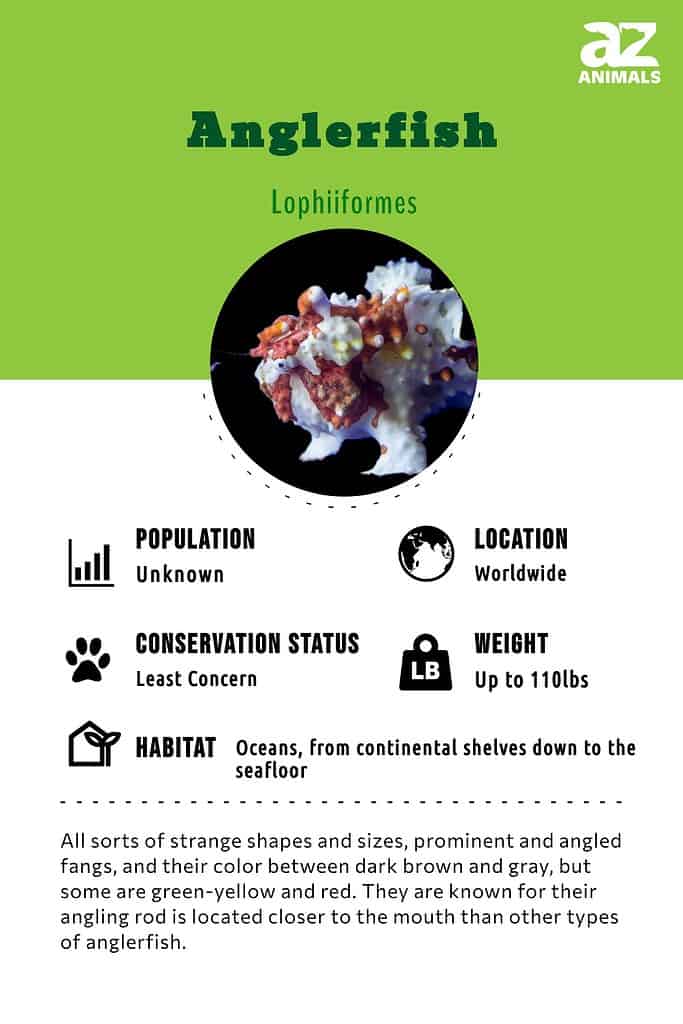
Types of Anglerfish
There are more than 200 documented species of anglerfish spread across 11 different families. These are some of the best-known types:
- Humpback Anglerfish – This species was one of the first anglerfish ever discovered and still shapes perceptions of what an anglerfish looks like. Featuring sharp fangs and a long lure, it stalks the ocean down to its depths.
- Monkfish – The monkfish, also known as a goosefish, is a family of anglerfish that inhabits continental shelves closer to the surface, making it accessible for humans to catch. The angling rod is located closer to the mouth than other types of anglerfish.
- Frogfish – Frogfish are a family of tropical fish whose bodies are covered in all manner of unique spines, thorns, appendages, and even algae to aid in camouflage and lure in prey. Some species even have the ability to change colors to match the surrounding environment. They almost resemble the stones or coral they swim among.
- Red-lipped Batfish – Red-lipped Batfish have disc-shaped, flattened bodies and pectoral, anal, and pelvic fins that behave like limbs. Their head is adorned with an illicium and esca. They are about 8 inches long, has a weight of fewer than 2.2 pounds. Of course, their lips are a deep, vivid red as if they had put on too much lipstick.
- Footballfish – Footballfish possesses a large, round, or oval-shaped body that resembles a football. They also have very sharp teeth and black or brown scales. The females measure up to 2 feet long and possess the large glowing angler rod that emerges from the head. They also have a covering of round, bony plates on their body.
- Striped Anglerfish – The Striped Anglerfish varies in color from individual to individual, and this is also true of their striped patterns that can be solid, broken patterns, and everything in between. They have up to seven lure appendages in which they lure their prey close.
- Sea Toad – Sea Toads and other benthic varieties of anglerfish live deep on the ocean floor. They have been found at depths of up to 8,000 feet, and they are located in the Indian, Pacific, and Atlantic Oceans. They have specialized gills and breathing capabilities that allow them to be mostly sedentary, which helps them stay very still in order to catch their prey and also go undetected by predators.
Appearance
The anglerfish comes in all sorts of strange shapes and sizes. While the round appearance is most well-known, some species are very long or even angular. Their crescent-shaped mouths bear many prominent fangs, angled inward to capture prey. Some species also have a muscular skin flap on the top of the head to hide or reveal its glowing lure; the lure itself can be straight, curved, or hooked. Their color normally ranges between dark brown and gray, but some are green-yellow and red.
The anglerfish has one of the strongest sexual differences in the entire animal kingdom. The male is much smaller than the female and may not have a lure. Sometimes he even looks like a completely different species. While males only measure about an inch long, females can reach up to 4 feet in size (though most are only a foot or two long).
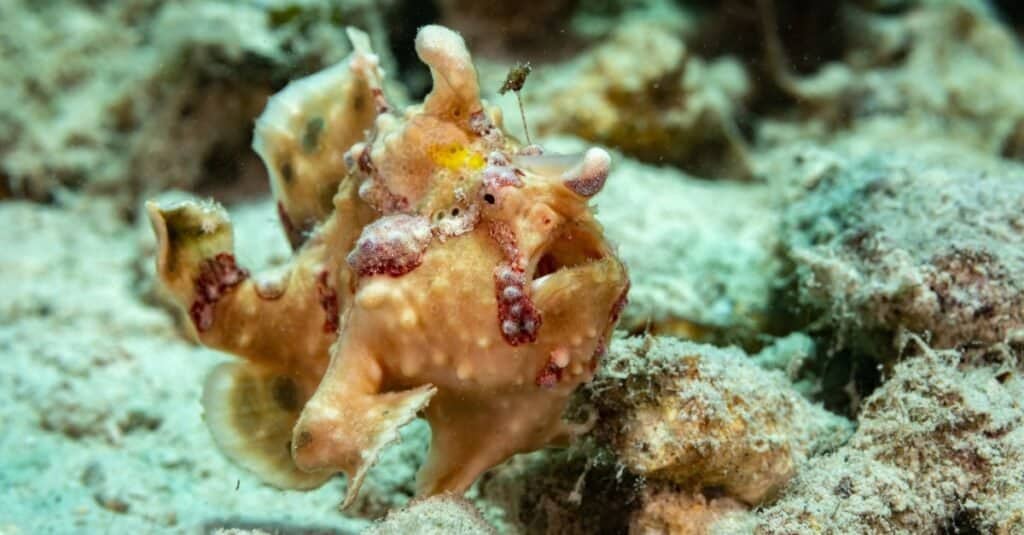
.
©Gerald Robert Fischer/Shutterstock.com
Distribution, Population, and Habitat
The anglerfish is found worldwide, from continental shelves down to the seafloor. While many are listed as least concern, it’s difficult to perform an accurate population assessment on them because of the extreme depths of their habitats.
Predators and Prey
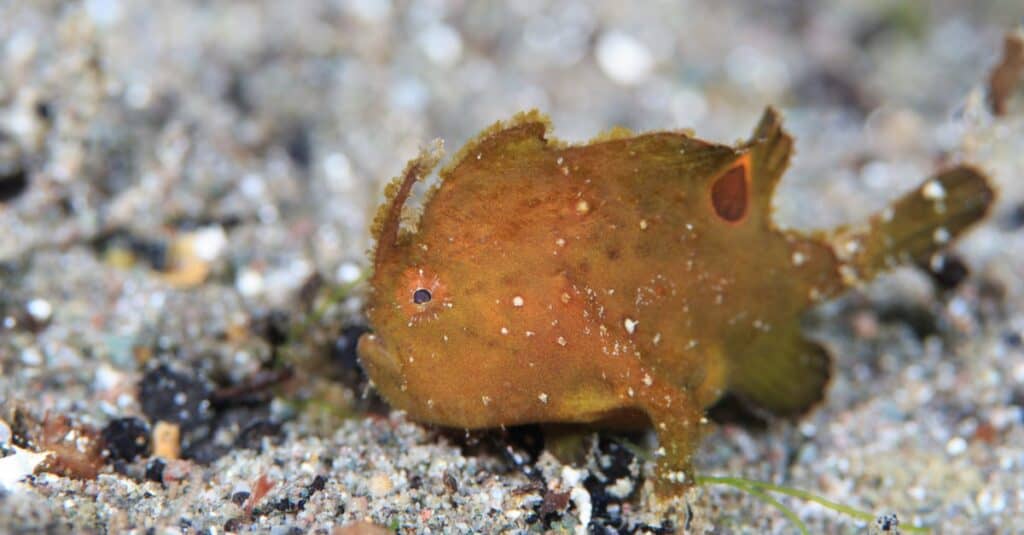
Anglerfish have very few predators.
©SergeUWPhoto/Shutterstock.com
The anglerfish sits near the top of the food chain in its deep-sea habitat, where few other large predators roam.
What eats them?
The anglerfish seems to have very few predators in its natural habitat besides humans and maybe some larger fish (like sharks).
What do they eat?
Crustaceans and fish (shrimp in particular) form the bulk of their diet. In order to capture its prey, the anglerfish will often pulse the light and move it back and forth in the water. Some species are so voracious they’ve been documented eating prey as large as their entire bodies.
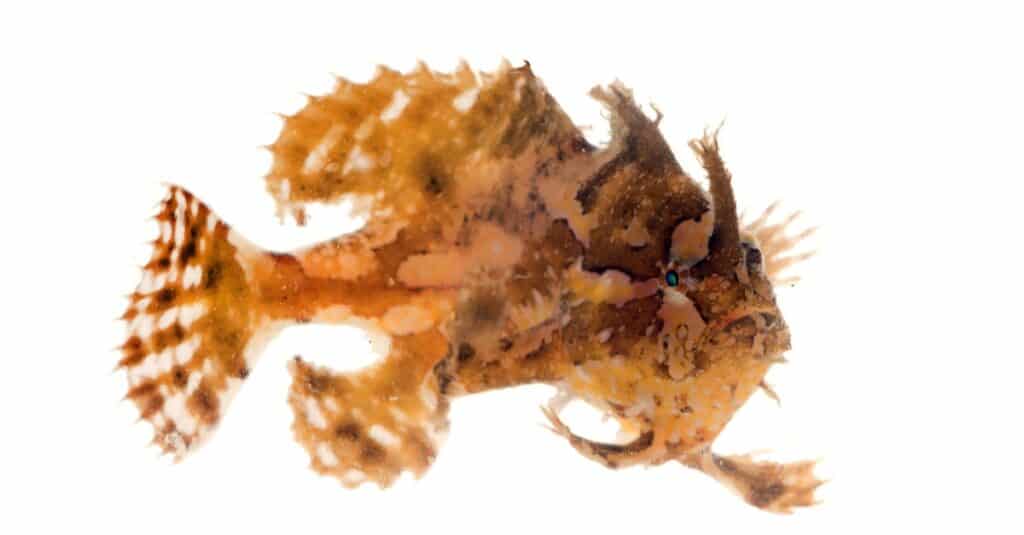
Shrimp form the bulk of an Anglerfish’s diet.
©IrinaK/Shutterstock.com
Reproduction and Lifespan
The anglerfish has evolved two distinctive reproductive strategies. The first and more traditional method of reproduction involves external fertilization. Although the pair forms a close physical union together, the female will release her eggs into the water, while the male will release his sperm to fertilize them. The male is then free to reproduce again with another female.
The second method is one of the most unique reproductive adaptations in the entire animal kingdom. This involved a fully symbiotic relationship between the mating pair. When the male finds a suitable mate, he will bite into her flesh and begin the process of fusing with her body down to the blood-vessel level. In exchange for sperm, he will receive nutrients directly from the female’s body. Males of these species might have highly undeveloped anatomy; they often have trouble finding food on their own, before attaching it to a mate, whom they depend on for sustenance. There are several theories for how this unique strategy evolved. One leading theory is that it evolved in response to low population density when the chances of finding another mate are low.
Regardless of the reproductive method, the rest of the development proceeds in a similar manner. A single female anglerfish can release millions of eggs, usually covered in a gelatinous substance. Gestation can take anywhere between a few days and a few weeks at a time until the eggs are ready to hatch. Unfortunately, there are still a lot of facts we don’t know about early anglerfish development. Presumably, given the number of eggs produced, early attrition among juveniles is quite high. The few fish that do survive into adulthood have a solid lifespan. Some of the females can live up to 25 years in the wild.

A single female anglerfish can release millions of eggs, usually covered in a gelatinous substance.
©iStock.com/plovets
History and Evolution
There are not many species in the Animal Kingdom that showcase how strong and amazing evolution can be than the Anglerfish. Not only do they have unique mating and relationships between sexes as seen in the reproduction section above, but they have evolved their spines to produce extremities that fool other animals into thinking they are food! Some types of Anglerfish have developed some of their spines and fins to function as legs to help them anchor to the ocean floor and become more mobile in that environment. While it may seem too cartoonish to be true, they evolved that way millions of years ago, and these characteristics and adaptations are what has allowed this species to thrive and survive in both shallow and deep waters around the world.
Fishing and Cooking
The deep-sea anglerfish is not very common in either recreational or commercial fishing. However, the goosefish from the family Lophiidae is considered to be a delicacy in many parts of the world. Their flesh can be steamed, sauteed, broiled, fried, and baked.
View all 194 animals that start with AAnglerfish FAQs (Frequently Asked Questions)
Where are anglerfish found?
Anglerfish are found all over the world, largely in deep tropical and temperate waters, but their extreme depths ensure that they rarely come into contact with people.
Are anglerfish blind?
While some species may have poor eyesight, none of them is completely blind. Most anglerfish actually have specialized eyes for seeing in deep-sea habitats.
Why are anglerfish so scary?
The anglerfish have sharp fangs and a bizarre, grizzled appearance; their isolated deep-sea habitat also makes them seem a little scary. But while they are voracious predators, they’re just like any other animal.
Do anglerfish still exist?
Yes, there are more than 200 species, most of them listed as least concern.
Do anglerfish bite humans?
Anglerfish rarely interact with humans in any meaningful way, but presumably, if they felt threatened, they could bite.
What is the biggest anglerfish ever found?
The biggest anglerfish ever found was more than 4 feet long.
What are the differences between a blanket octopus and an anglerfish?
The main difference between a blanket octopus and an anglerfish is that blanket octopuses are surface to mid-waters dwelling pelagic cephalopods, while anglerfishes are deepwater-dwelling apex predators. Other differences between the two are size, diet, habitat, reproduction, and lifespan.
Thank you for reading! Have some feedback for us? Contact the AZ Animals editorial team.
Sources
- Oceana / Accessed August 29, 2021
- Britannica / Accessed August 29, 2021


















